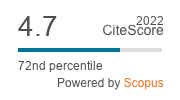Random collections of ears of winter wheat cultivars grown within the Czech Republic were made during 2004-2013. The ears were assessed for Fusarium head blight symptoms on a 0-9 scale and grain samples were analysed for deoxynivalenol (DON) content by enzyme-linked immunosorbent assay. Samples from 2011-2013 were analysed in greater detail, including to detect Fusarium species using polymerase chain reaction assays and determine mycotoxin content (including ‘emerging’ mycotoxins) using ultra-high performance liquid chromatography coupled with tandem mass spectrometry. The 10-year survey reveals a significant adverse effect from maize as the preceding crop on the accumulation of DON. Most endangered were those areas situated in the eastern part of the country. The study revealed prevailing occurrence of Fusarium poae and Fusarium graminearum within the Czech Republic. The occurrence of F. poae increased greatly in 2012 (with 93.3% of samples infected) in association with relatively warmer and drier weather. These investigations provide abundant evidence as to the presence of so-called ‘emerging’ mycotoxins, particularly enniatins. The survey also shows that increased content of ‘emerging’ mycotoxins could be accompanied by high DON content through mixed infections. Among examined toxins, only DON and DON-3-glucoside (DON-3G) were positively correlated (r=0.800; P<0.001) while levels of the remaining toxins were independent of one another. DON production by both DON-producing species F. graminearum and Fusarium culmorum was significantly higher in mixed infections with other species. The presence of Fusarium avenaceum with other species appeared markedly to promote the production of 5 out of 6 mycotoxins, namely DON, DON-3G, nivalenol, enniatins, and beauvericin. These five mycotoxins profited also from contamination by F. poae. Moreover, the presence of F. graminearum and F. culmorum appeared to be decisive for zearalenone accumulation, which was not correlated with DON levels.
RESEARCH ARTICLE
Occurrence of Fusarium species and mycotoxins in wheat grain collected in the Czech Republic
J. Chrpová Related information
1Division of Crop Genetics and Breeding, Crop Research Institute, Drnovská 507, 161 06 Prague 6,Czech Republic
*chrpova@vurv.
, V. Šíp Related information*chrpova@vurv.
1Division of Crop Genetics and Breeding, Crop Research Institute, Drnovská 507, 161 06 Prague 6,Czech Republic
, T. Sumíková Related information1Division of Crop Genetics and Breeding, Crop Research Institute, Drnovská 507, 161 06 Prague 6,Czech Republic
, J. Salava Related information2Division of Crop Protection and Plant Health, Crop Research Institute, Drnovská 507, 161 06 Prague 6, Czech Republic
, J. Palicová Related information1Division of Crop Genetics and Breeding, Crop Research Institute, Drnovská 507, 161 06 Prague 6,Czech Republic
, L. Štočková Related information1Division of Crop Genetics and Breeding, Crop Research Institute, Drnovská 507, 161 06 Prague 6,Czech Republic
, Z. Džuman Related information3Department of Food Analysis and Nutrition, University of Chemistry and Technology, Technická 5, 166 28 Prague, Czech Republic
, J. Hajšlová Related information3Department of Food Analysis and Nutrition, University of Chemistry and Technology, Technická 5, 166 28 Prague, Czech Republic
World Mycotoxin Journal: 9
(2)- Pages: 317 - 327
Published Online: September 30, 2015
Abstract
2023 Journal Impact Factor
2.0
source: Journal Impact Factor 2023™ from Clarivate™

Institutional Offers
For institutional orders, please contact [email protected].
Purchase Options
-
P. Battilani and M. Camardo Leggieri
-
F. Xu, R.C. Baker, T.B. Whitaker, H. Luo, Y. Zhao, A. Stevenson, C.J. Boesch and G. Zhang
-
A.O. Aasa, F.F. Fru, O.A. Adelusi, S.A. Oyeyinka and P.B. Njobeh
-
F. Wu
-
V. Ostry
-
V. Ostry
-
R. Bandyopadhyay, A. Ortega-Beltran, A. Akande, C. Mutegi, J. Atehnkeng, L. Kaptoge, A.L. Senghor, B.N. Adhikari and P.J. Cotty
-
A. Logrieco, A. Moretti and M. Solfrizzo
-
G. Schatzmayr and E. Streit
-
B. Grenier and I. Oswald



